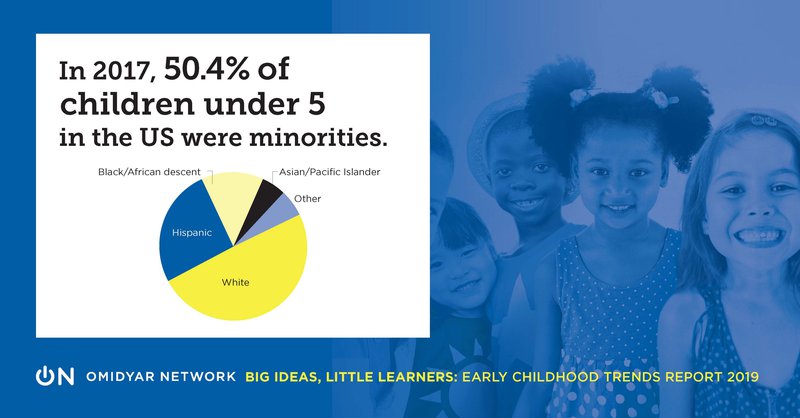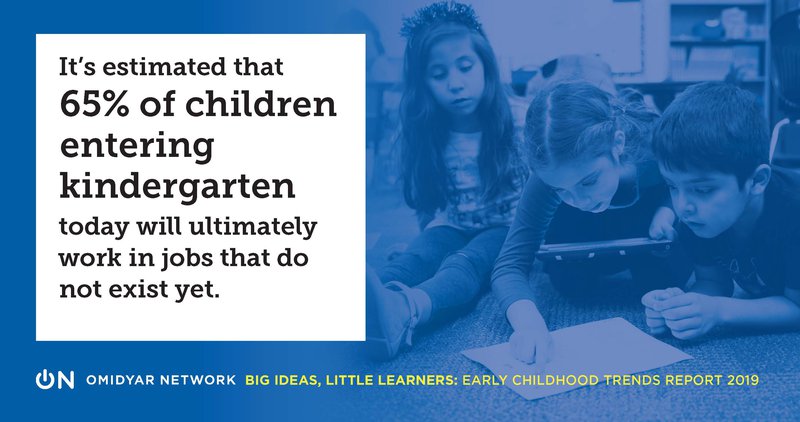Big Ideas, Little Learners

Looking Back: Early Childhood Progress in Past 50 Years
In 2018 we celebrated the 50th anniversary of Mister Rogers’ Neighborhood — an icon of encouragement that positively educated millions of young children. Only a few years before the show debuted, Head Start piloted a successful eight-week summer program in 1965. It subsequently scaled the program nationally as part of the War On Poverty. Sesame Workshop was born shortly afterwards. There is no question that the past 50 years have seen major progress in practices for young children and families.
In addition, tremendous breakthroughs in brain science have clearly established why the early years are so critical in a young child’s development. We now understand how children learn and develop with increasing precision. Furthermore, we can even make a powerful economic case for investing: well-designed early childhood programs have been proven to yield demonstrable societal returns — 13 percent — one of the highest societal returns of investment ever measured.

Time Is Now
Understanding of the importance of the early years is becoming mainstream. National, state, city, and local policymakers are starting to pay attention. Parents have also heard the message, and families are increasing how much they spend on early childhood, especially those who have the ability to do so.
Despite these upward trends, early childhood remains massively under-invested in the US compared to other nations and to what we spend on other age groups. Early childhood educators and programs are underfunded relative to the proven needs, and it is leaving too many children and families behind. According to the Human Capital Index recently released by the World Bank, the US education system is estimated to only deliver 76 percent of human potential (on par with Serbia).
So, how do we close the gap between the growing demand from a new generation of parents, educators, and policymakers who recognize the importance of early childhood education and the relative scarcity of scalable solutions that would allow each and every young child to thrive?
While we absolutely must increase public funding for evidence-based solutions, such as quality pre-K programs, Early Head Start and home visitation programs, and increase the compensation and stature of the early childhood workforce, we at Omidyar Network also believe that we need to attract entrepreneurial and leadership talent to the early childhood field along with innovation-focused capital to ultimately increase the supply of quality solutions.
With the release of our report Big Ideas, Little Learners: Early Childhood Trends Report, we hope to showcase the megatrends driving new demand and supply in early childhood education. We hope that it will ignite even more conversations, ideas, actions, and energy into the space.
Let us walk you through some of the most interesting trends we highlight:
Demand: A New America
The structure of American families has dramatically changed, which means we have increasing and different child care needs. Two-thirds of children under five now live in homes where both parents work, compared with fewer than one in 10 in 1940. And, a quarter of all post-secondary students must care for a dependent child. With the structure of American families changing, so too do the demographics. In 2017, the majority of children under the age of five were children of color.

As generations shift over time, parents’ and educators’ expectations also evolve. As mobile device penetration and social media usage increases, Gen Y (millennial) and Gen Z parents and educators have different habits and behaviors for how they receive information, find services (including child care), and connect to meet their modern parenting needs or teaching practices. For example, 71 percent of Gen Y parents report valuing advice from parenting blogs, websites, and social media.
Supply: Promising New Innovation, Talent, and Funding
We are encouraged by the rise of both nonprofit and for-profit entrepreneurship, including more founders who are representative of the communities they are serving. Moreover, public and private funding for early childhood programs in the US is steadily rising (up 17 percent and 12 percent respectively in the past two years).
As technology advances in all other aspects of our lives, its benefits are finally being translated into innovations for early childhood. Technologies are helping reach more diverse children, including refugees, children in rural areas, dual language learners, and children with special needs. The increasing capacity of artificial intelligence to process data and make recommendations is also starting to penetrate early childhood, including through wearables, assessment, behavioral nudges such as fun facts and easy tips on parenting via text messages, and learning pathways.
However, innovation is not just about technology. There are also exciting new developments in distribution and platform models for the early childhood workforce, new ways to foster adult-child interactions, new policies, and new modes of collaboration and collective impact.
Looking Forward: From Scarcity to Possibility
The future is upon us, and the future never stops. We hope our trend report Big Ideas, Little Learners is helpful not just for examining the megatrends impacting our present and future, but for understanding those burgeoning innovations that have the potential to increase quality, affordability, and relevancy of solutions to meet the needs and aspirations of modern parents, educators, and our diverse little learners.

We also recognize that innovations, pursued haphazardly, can make our society more inequitable or have negative consequences. So much great progress is possible. It is up to all of us to ensure that those innovations we pursue unlock human potential, so that every child thrives and contributes to a changing and interdependent world. Let’s move from scarcity to possibility.
Download the full report and read more about Big Ideas, Little Learners.
A version of this story first appeared on Techonomy.